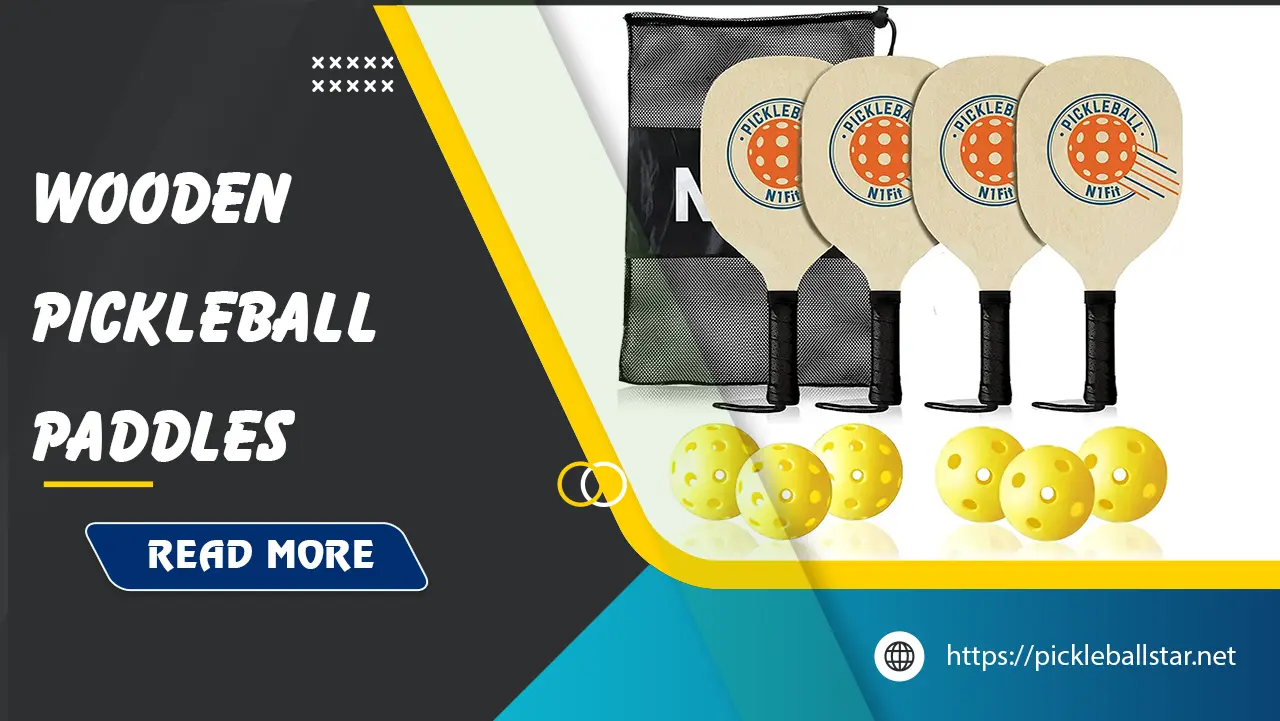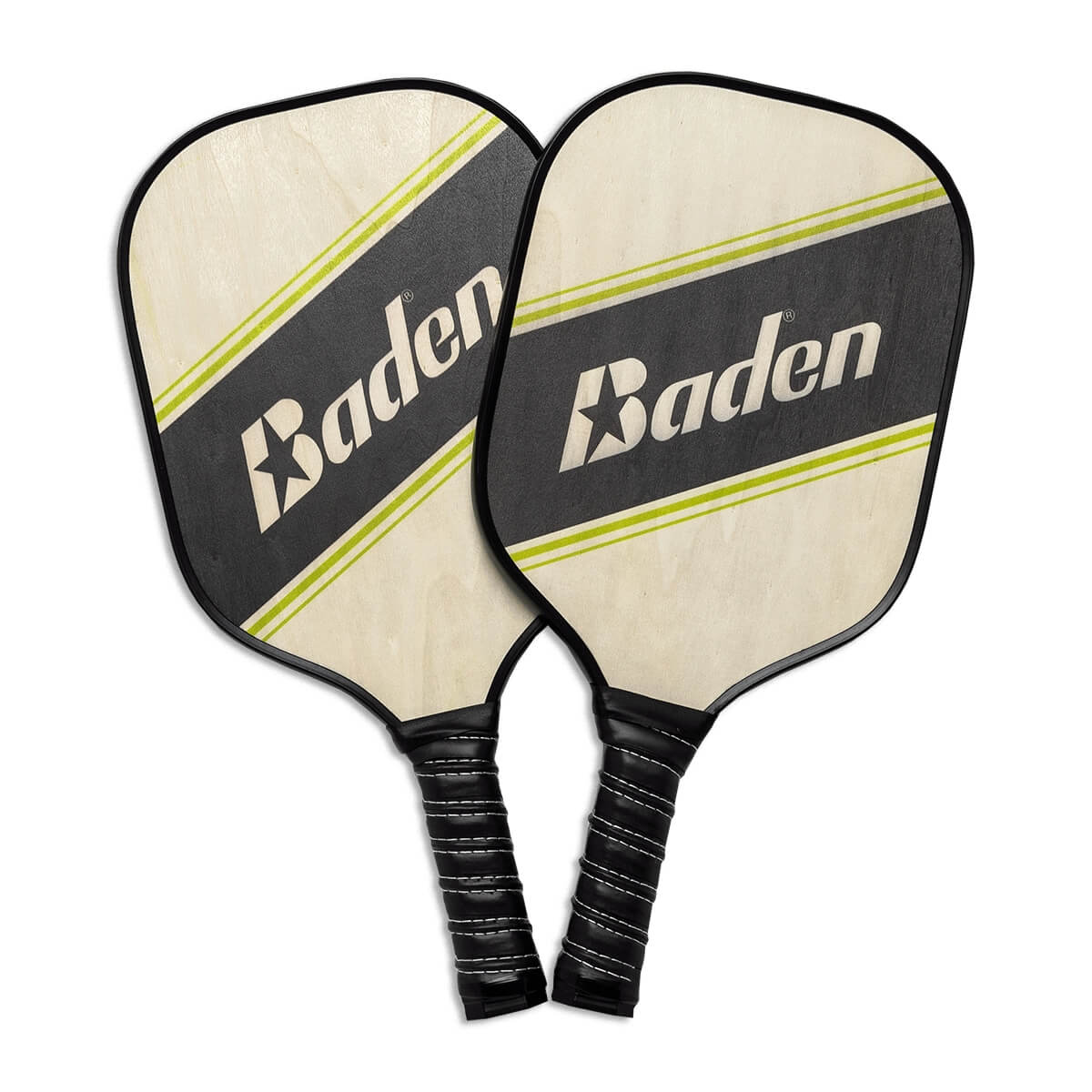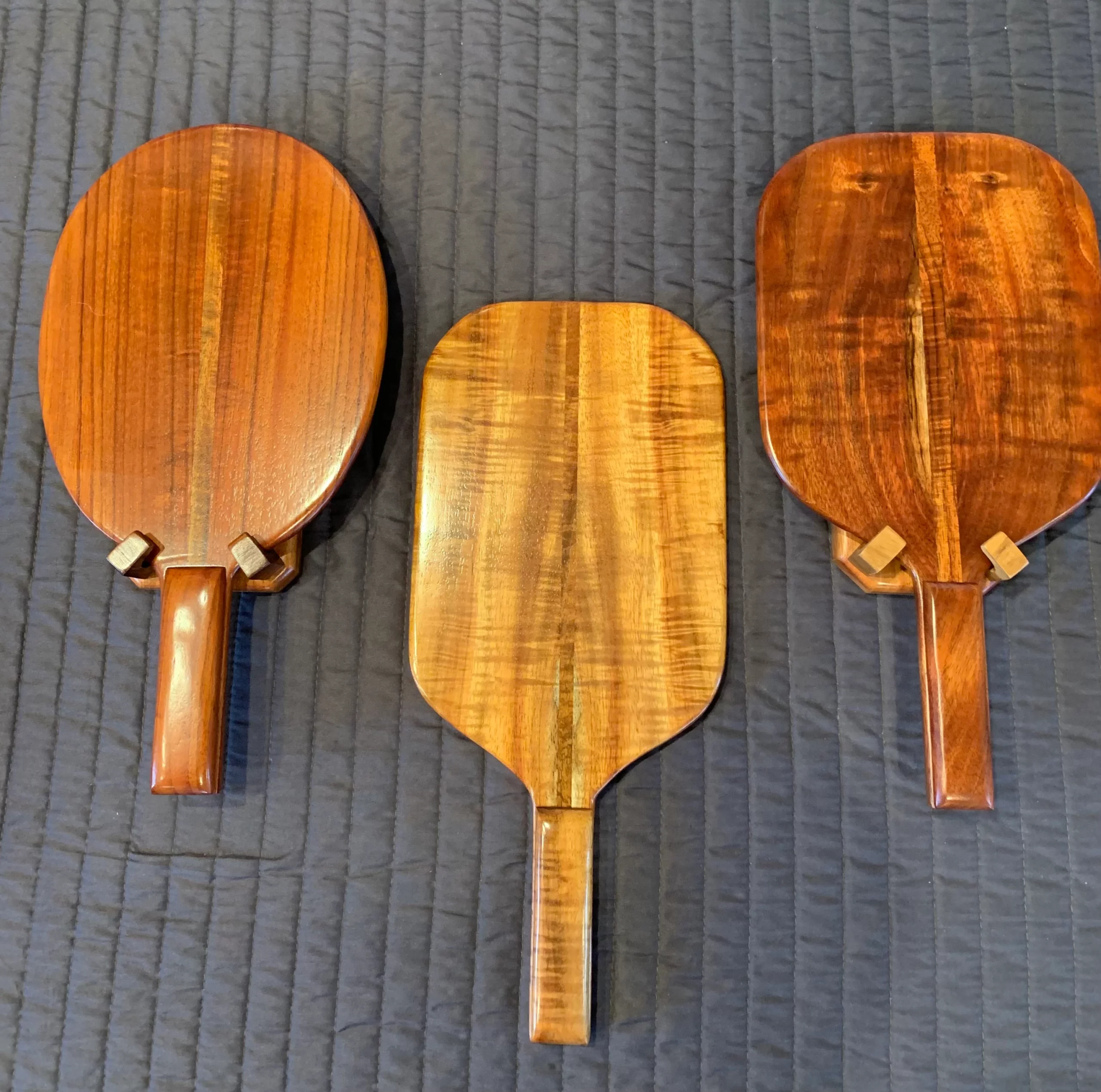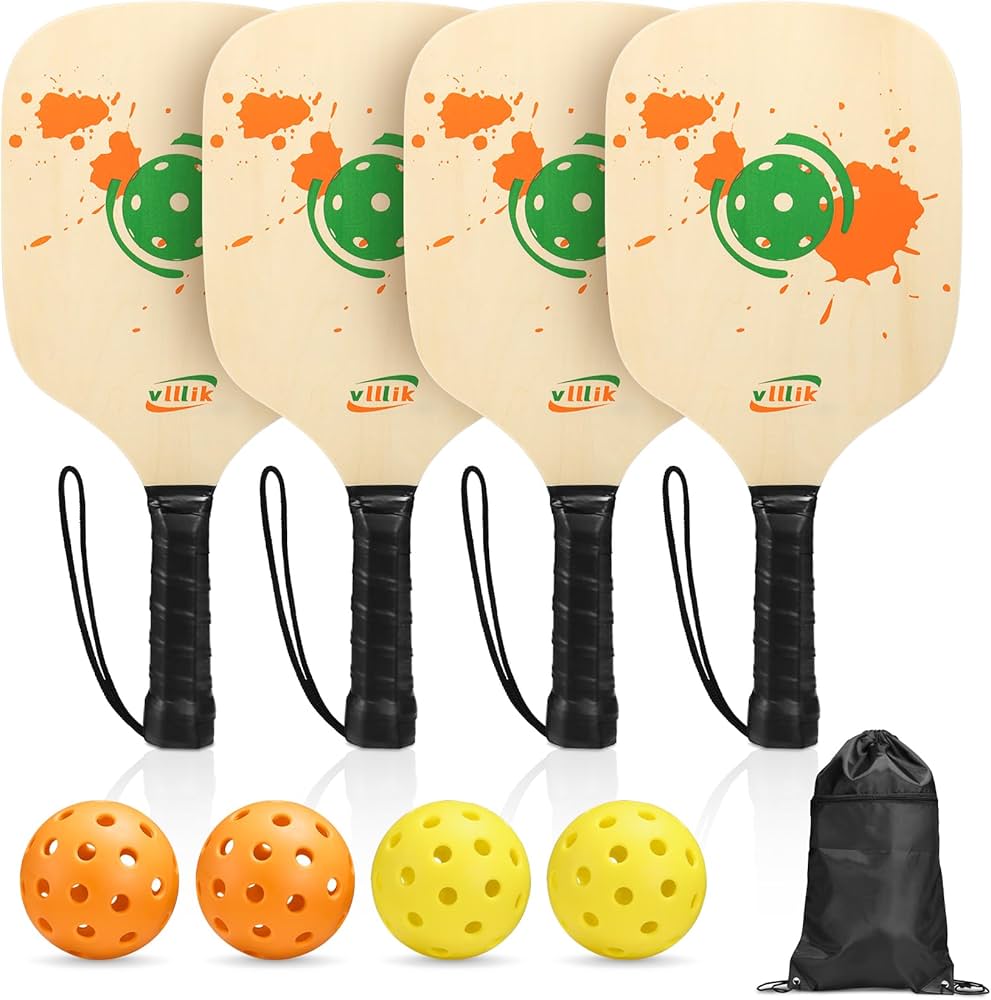Exploring the World of Wooden Pickleball Paddles
Pickleball paddle materials have evolved over time, offering a range of options to suit different playing styles and preferences. Wood paddles represent a traditional choice, often favored by players who appreciate a natural feel and a connection to the classic game. While they might not be as widely used as modern composite paddles, wooden pickleball paddles offer a unique and rewarding experience for those who value craftsmanship and a classic touch.

Wooden pickleball paddles are known for their distinct feel, responsiveness, and durability. They provide a unique “pop” when hitting the ball and often offer a more tactile connection to the game. Wooden paddles can be surprisingly durable and long-lasting when properly cared for, making them a worthwhile investment for players who appreciate traditional craftsmanship and a classic playing experience.
The Advantages of Wooden Pickleball Paddles: A Unique Feel and Performance

The Natural Feel of Wood: A Responsive and Tactile Experience
The charm of wooden pickleball paddles lies in their organic touch and tactile feedback. When the ball meets the paddle, there’s an unmistakable, satisfying “pop” that resonates through the handle, giving the player an immediate sense of connection with the game. This responsive sensation is akin to feeling the raw power of an expertly crafted wooden baseball bat or the soulful resonance of a finely tuned acoustic guitar. The solid wood construction provides a more tactile experience, allowing players to feel the ball impact and control the shot more precisely.
This natural feel is a stark contrast to composite paddles, which can often feel mechanically detached from the ball. Wooden paddles act almost like an extension of your hand, offering a soft yet firm contact that allows for intricate shot-making. Whether you’re executing a gentle dink or a powerful drive, the feedback from a wooden paddle enhances your shot precision and control, almost like a maestro guiding an orchestra with every stroke.
Durability and Longevity: A Well-Crafted Paddle Can Last for Years
Durability is another cornerstone of wooden pickleball paddles. While composite materials boast advanced engineering, they often fall short in resilience. In an age of disposable products, a well-crafted wooden paddle is a testament to time-honored durability. They resist cracks and splinters much better when properly maintained, offering a sense of reliability and endurance.
Consider the robustness of hardwoods like maple or walnut. These materials are not just strong; they age gracefully, bearing the marks of your battles on the court like badges of honor. When you invest in a wooden paddle, you’re not just buying a piece of sports equipment you’re gaining a companion that can share countless games and grow with you over the years.
A Touch of Tradition: Connecting with the Classic Game
Using a wooden pickleball paddle is like taking a step back in time. It’s reminiscent of the sport’s early days when players carved their paddles from wood and played for the sheer love of the game. This connection to the sport’s origins adds a nostalgic element to your play. Every time you grip a wooden paddle, you’re not just holding a piece of equipment; you’re holding a piece of pickleball history.
This traditional charm is especially appealing in a world increasingly dominated by mass-produced, technologically sophisticated gear. The craftsmanship involved in creating a wooden paddle each carve, each polish, each finish is palpable. It transforms your game from a purely physical exercise to an emotional journey, connecting you to the essence of pickleball in a deeply personal way.
Read more: Wood vs Graphite Pickleball Paddles: A Comprehensive Comparison
Choosing the Right Wooden Pickleball Paddle: Factors to Consider
Wood Type: Impacting Performance and Feel
Selecting the right wood type is paramount when choosing your paddle. Different woods bring varied characteristics to the table, influencing both performance and feel.

- Maple: Known for its exceptional hardness and smooth surface, maple provides a solid, dependable response. It’s a great choice for players looking for consistency and reliability.
- Walnut: Offers a slightly softer feel compared to maple. Its rich grain makes for paddles that are not only effective but also aesthetically pleasing, perfect for those who value beauty as much as function.
- Birch: This wood strikes an excellent balance between hardness and flexibility. Birch paddles offer a comfortable hit with a medium weight, making them versatile options for a wide range of playing styles.
Construction and Design: Finding the Right Balance
The construction techniques employed in wooden paddles greatly impact their performance. Some paddles feature a solid wood construction, while others use laminated layers for added strength and flexibility. This is where the craftsmanship really shines through.
- Solid Wood Paddles: Typically, these are heavier but offer a powerful hit. They are made from a single piece of wood or several layers of the same wood type. Ideal for players who prefer a paddle with substantial heft and power.
- Laminated Wood Paddles: These paddles are crafted by layering different wood types. This can result in a lighter paddle with improved durability and a unique feel. Layering also adds to the aesthetic value, giving the paddle a distinct, beautiful look.
Paddle Weight and Grip: Matching the Paddle to Your Swing
The weight and grip of a wooden paddle are critical factors that can significantly affect your playing style and comfort. A paddle that’s well-suited to your hand and swing can greatly enhance your game.
- Weight: Wooden paddles generally range from mid to heavy, around 7.5 to 9.5 ounces. Heavier paddles offer more power but can be more taxing over long games. Lighter paddles are easier on the arm but may sacrifice some power.
- Grip Size: Finding the right grip size is crucial for comfort and control. A paddle with too large a grip can cause strain and reduce maneuverability, while a too-small grip can lead to instability and a weaker hold. The grip should feel comfortable in your hand, neither too tight nor too loose.
Read more: Wood vs Fiberglass Pickleball Paddles: Expert Comparison
Caring for Your Wooden Pickleball Paddle: Tips for Longevity

Proper Storage: Protecting Your Paddle from the Elements
Proper storage plays a vital role in maintaining your wooden paddle’s condition. Exposure to extreme temperatures, humidity, and direct sunlight can cause wood to warp or crack.
- Ideal Conditions: Store your paddle in a cool, dry place away from direct sunlight. Extreme cold or heat can negatively affect the wood’s integrity.
- Paddle Bags: Investing in a good paddle bag can offer additional protection from dust, moisture, and accidental drops. Opt for padded bags designed specifically for pickleball paddles.
Regular Maintenance: Inspecting and Cleaning Your Paddle
Regular inspection and cleaning are essential to keep your paddle in top shape. Over time, dirt and sweat can accumulate, leading to deterioration if not managed properly.
- Cleaning Tips:
- Solid Wood Paddles: Use a damp cloth to wipe down the paddle after each use. Avoid soaking the wood, as excessive water can cause swelling and warping.
- Laminated Wood Paddles: Similar cleaning methods apply, but you can be a bit more thorough due to the added protection of the laminate layers.
- Hybrid Wood Paddles: Treat them like solid wood paddles, focusing on gentle cleaning methods.
Treating the Wood: Maintaining its Natural Beauty and Durability
To maintain the wood’s natural beauty and durability, periodic treatment with a light oil or sealant can be beneficial.
- Oiling: Apply a thin layer of wood oil (like linseed or mineral oil) to the paddle’s surface. This preserves the wood’s moisture balance and enhances its natural grain.
- Sealant: For added protection, consider using a wood sealant. This can help shield the paddle from moisture and environmental factors, extending its lifespan significantly.
Common Questions
Are wood paddles still relevant in today’s pickleball world?
Absolutely. While modern materials offer various advantages, wood paddles remain relevant, particularly for those who value the traditional feel and connection to the game’s roots. Their classic touch and reliability continue to draw players who appreciate the tactile feedback and craftsmanship of wood.
What is the difference between a solid wood paddle and a paddle with a composite core?
A solid wood paddle is typically made entirely from one or more types of wood, offering a robust and traditional feel. In contrast, a composite core paddle generally has a wooden exterior but features a core made from composite materials, providing a balance of wood’s feel and the enhanced performance attributes of modern materials.
Read more: Composite vs Wood pickleball paddles – A Comprehensive Compare
What are some popular pickleball paddle brands that offer wood paddles?
There are several brands known for their quality wooden paddles:
- Onix: Renowned for high-quality wooden paddles with various shapes and designs.
- Gamma: Offers durable and affordable wooden paddles suitable for both beginners and experienced players.
- Selkirk: Provides a range of wooden paddles with different grip sizes and weight options.
How do wood paddles compare to carbon fiber or composite paddles in terms of performance and feel?
Wood paddles offer a unique, tactile experience and a traditional feel that’s hard to match. They provide excellent control but may lag behind in power compared to carbon fiber or composite paddles, which are generally lighter and offer greater maneuverability and power. However, wooden paddles are often more affordable and durable when maintained properly.
Read more: Wood vs Carbon Fiber Pickleball Paddles: How to choose?
Conclusion
Wooden pickleball paddles offer a unique and traditional playing experience, providing a natural feel and a touch of nostalgia. By understanding the advantages of wood paddles and properly caring for your equipment, you can enjoy a fulfilling and rewarding game. While modern materials offer advantages, there’s a special charm and performance to be found in a well-crafted wood paddle.
Explore the world of wooden pickleball paddles and discover the classic feel and performance that can elevate your game. Embrace the tradition and craftsmanship that make wood paddles a unique and rewarding choice for pickleball players of all levels. Whether you’re a seasoned player or a beginner, the allure of wood can bring a special quality to your matches, blending the past with the present in every swing.
